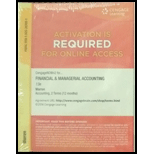
Concept explainers
1. (a)
Methods of Depreciation: Depreciation refers to the reduction in the monetary value of a fixed asset due to its wear and tear, or obsolescence. It is a method of distributing the cost of the fixed assets over its estimated useful life.
The three methods of depreciation are:
- Straight-line method: Under the straight-line method of depreciation, the same amount of depreciation is allocated every year over the estimated useful life of an asset.
- Units-of-activity method: In this method of depreciation, the amount of depreciation is charged based on the unit of production each year.
- Double-declining balance method (Accelerated method): In this method of depreciation, the diminishing value of the asset is taken into consideration for determining the depreciation for the succeeding years.
the amount of depreciation for four years ending December 31 by straight-line method.
1. (a)
Explanation of Solution
Determine the amount of depreciation for four years ending December 31 by straight-line method.
2014:
Cost of the equipment= $108,000
Residual value of the equipment = $7,200
Estimated Useful life of the equipment = 3 years
Number of months equipment used =3 months (October 1-December 31)
2015:
Cost of the equipment= $108,000
Residual value of the equipment = $7,200
Estimated Useful life of the equipment = 3 years
Number of months equipment used =12 months (January 1-Deccember 31)
2016:
Cost of the equipment= $108,000
Residual value of the equipment = $7,200
Estimated Useful life of the equipment = 3 years
Number of months equipment used =12 months (January 1-Deccember 31)
2017:
Cost of the equipment= $108,000
Residual value of the equipment = $7,200
Estimated Useful life of the equipment = 3 years
Number of months equipment used =9 months (January 1-September 30)
Therefore, the amount of depreciation ending December 31 by straight-line method for 2014 is $8,400, 2015:$33,600, 2016: $33,600, and 2017: $25,200.
(b)
the amount of depreciation for four years ending December 31 by units-of-activity method.
(b)
Explanation of Solution
Determine the amount of depreciation for four years ending December 31 by units-of-activity method.
| Year | Number of Hours (A) | Depreciation Expense (A×B) | |
| 2014 | 1,350 | $8.40 | $11,340 |
| 2015 | 4,200 | $8.40 | $35,280 |
| 2017 | 3,650 | $8.40 | $30,660 |
| 2017 | 2,800 | $8.40 | $23,520 |
Table (1)
Working note:
Determine the depreciable rate of the equipment.
Cost of the equipment= $108,000
Residual value of the equipment = $7,200
Estimated Useful life of the equipment = 12,000 operating hours.
Therefore, the amounts of depreciation for three years ending December 31 by units-of-activity method are 2014: $11,340, 2015: $35,280, 2016: $30,660, and 2017: $23,520.
(c)
the amount of depreciation for four years ending December 31 by double-declining-balance method.
(c)
Explanation of Solution
Determine the amount of depreciation for four years ending December 31 by double-declining-balance method.
2014:
Cost of the equipment= $108,000
Estimated Useful life of the equipment = 3 years
Number of months equipment used =3 months (October 1-December 31)
2015:
Cost of the equipment= $108,000
Estimated Useful life of the equipment = 3 years
Number of months equipment used =12 months (January 1-December 31)
2016:
Cost of the equipment= $108,000
Accumulated Depreciation=
Estimated Useful life of the equipment = 3 years
Number of months equipment used =12 months (January 1-December 31)
2017:
Notes:
Accumulated depreciation is the sum total of the previous years’ depreciation expense.
The depreciation expense should not exceed the residual value of $7,200. Thus, it should be adjusted to make the book value of the equipment (cost less accumulated depreciation) equal to its residual value. Thus, the depreciation expense for 2017 would be
Therefore, the amounts of depreciation for four years ending December 31 by double-declining-balance method are 2014: $18,000, 2015: $60,000, 2016: $20,000, and 2017:$2,800.
Want to see more full solutions like this?
Chapter 9 Solutions
CengageNOWv2, 2 terms Printed Access Card for Warren?s Financial & Managerial Accounting, 13th, 13th Edition
- I need assistance with this accounting question using appropriate principles.arrow_forwardIf sales revenue is $280 million and accounts receivable decreased by $30 million, the amount of cash received from customers: a. was $280 million. b. was $310 million. c. depends on the mix of cash sales and credit sales. d. was $250 million.arrow_forwardWhat is the flexible budget net income?arrow_forward
- Brookline Engineering forecasts that total overhead for the current year will be $9,000,000, and that total machine hours will be 150,000 hours. Year to date, the actual overhead is $9,600,000, and actual machine hours are160,000 hours. Suppose Brookline Engineering uses a predetermined overhead rate based on machine hours to apply overhead as of this point in time (year to date). In that case, the overhead is?arrow_forwardWhat was the balance in Quibi's Finished goods on November 1?arrow_forwardPlease provide the correct solution to this financial accounting question using valid principles.arrow_forward
 Financial Accounting: The Impact on Decision Make...AccountingISBN:9781305654174Author:Gary A. Porter, Curtis L. NortonPublisher:Cengage Learning
Financial Accounting: The Impact on Decision Make...AccountingISBN:9781305654174Author:Gary A. Porter, Curtis L. NortonPublisher:Cengage Learning Intermediate Accounting: Reporting And AnalysisAccountingISBN:9781337788281Author:James M. Wahlen, Jefferson P. Jones, Donald PagachPublisher:Cengage Learning
Intermediate Accounting: Reporting And AnalysisAccountingISBN:9781337788281Author:James M. Wahlen, Jefferson P. Jones, Donald PagachPublisher:Cengage Learning College Accounting, Chapters 1-27AccountingISBN:9781337794756Author:HEINTZ, James A.Publisher:Cengage Learning,Principles of Accounting Volume 1AccountingISBN:9781947172685Author:OpenStaxPublisher:OpenStax College
College Accounting, Chapters 1-27AccountingISBN:9781337794756Author:HEINTZ, James A.Publisher:Cengage Learning,Principles of Accounting Volume 1AccountingISBN:9781947172685Author:OpenStaxPublisher:OpenStax College Cornerstones of Financial AccountingAccountingISBN:9781337690881Author:Jay Rich, Jeff JonesPublisher:Cengage Learning
Cornerstones of Financial AccountingAccountingISBN:9781337690881Author:Jay Rich, Jeff JonesPublisher:Cengage Learning





